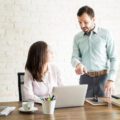Workplace psychologist Dr. Chris Allen helps organizations get results by developing teams that create high value. As a Forbes Coaches Council contributor, Dr. Allen offers regular insights on topics such as changing organizational culture, aligning cultural values, team building and team coaching in Forbes.com articles and offers quick advice via the Forbes Q/A feature.
Read this article on Forbes: “Five Ways Organizations Can Level Up Their Team Building”

Team development activities shouldn’t rely on trust falls, ropes courses or preparing a meal together. Although these activities can be fun and help people to build trust by getting to know one another better, there need to be activities more directly linked to team goals. Here are five ways to improve team building at your organization:
1. Incorporate interpersonal style assessments.
Team-building activities can involve interpersonal styles assessments as a means of improving trust and psychological safety. Using tools such as the Myers-Briggs Type Indicator or DiSC assessment, team members learn about one another’s personality strengths and vulnerabilities, their motivators and drivers, how they like to communicate and more. Through skillful use of such tools, team members learn to respect differences, develop psychological safety and collaborate effectively. In addition, a team-level assessment can be used to see how well the team works together.
2. Determine the ‘rules of engagement.’
In other words, what are the rules that will guide how we are going to work together toward common goals? Once team members understand each other’s preferences for communication via an interpersonal style assessment, they can decide on the rules of the road for how they want to manage conflict or how they want to address accountability. It becomes safer for team members to hold one another accountable for achieving goals. It is not solely the team leader’s job to hold team members accountable. In a healthy team, there is peer-to-peer accountability.
3. Focus on what’s good for the entire organization.
Team building is typically focused on improving functioning within the team. What’s the problem with this? It can sometimes lead to siloed thinking, where team members feel they are only responsible for one area. For example, you might hear, “I am a chief financial officer. I don’t know how we should recruit new customers; that’s not my job.” Or maybe a sales team knocks it out of the park in terms of meeting its goals but doesn’t realize how that can cause problems for a production or manufacturing team if there is no focus on collaboration and shared accountability among the various sub-teams. There needs to be an explicit focus on working together for the good of the whole, no matter what your functional area is.
4. Create a follow-up plan (and actually execute it).
Team-building activities typically occur during offsites or team retreats where team members feel energized and excited about what they have learned, but there is little (or sometimes no) follow-up planned. Without follow-up, how can the team maintain its commitments to working agreements, cross-functional collaboration and peer-to-peer accountability?
Sometimes at the offsite, leaders and their teams will work out specific plans to meet monthly to reflect and discuss how they are doing on the commitments they have made at the offsite. While promising, these commitments frequently go by the wayside because teams understandably get caught up in “business as usual” and the things that they must do for the organization to be successful. A good analogy is when you finish physical therapy and are supposed to continue specific exercises for the injured body part. This plan can fall apart when you are on your own with no one to ensure you are doing the exercises and continuing to make progress.
5. Consider team coaching.
In individual coaching, the coach and leader understand that change requires clear goals and a commitment to working overtime toward the goals with one’s coach. Coaching the whole team is a relatively recent phenomenon in team effectiveness work.
In team coaching, a coach has the opportunity to follow up quarterly, for example, and coach individual team members so that they bring their best to support the team goals. The coach also has the chance to come alongside the team in their “business as usual” meetings to assist them, as needed, in achieving the goals they may have set for the team during the offsite.
In systemic team coaching, the team coach goes even further, looking at the functioning of the team within the broader context of various stakeholder needs and expectations, such as the board, the suppliers, direct reports and line staff, customers/clients, vendors and the like. They can also examine the broader context in which the team and organization function, such as the current economic context, which includes rising inflation and the Great Resignation.
To create value for the organization and all of the stakeholders involved, take team building a step further by incorporating personal and team-wide assessments, focusing on the organization as a whole, implementing an actionable follow-up plan and considering team coaching.







0 Comments